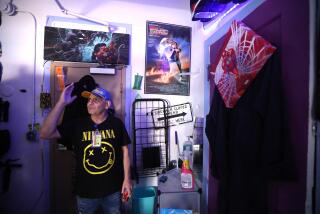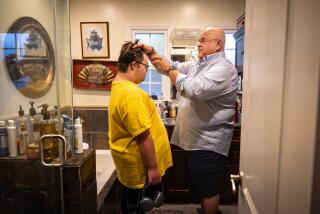New Center Seen as Symbol of Caring for Gay Community : Social services: $1.1 million of the purchase price is from bequests by those who have fallen to AIDS. A loan from the city has prompted critics to question the use of needed funds on a single project.
It was about 1987, Torie Osborn recalls, when Los Angeles’ primary community center for gays and lesbians began losing the battle to accommodate everyone needing its services.
Gay men and lesbians were coming in by the thousands to the Los Angeles Gay & Lesbian Community Services Center in Hollywood for testing, counseling, medical services and a variety of community programs, some AIDS-related and some not. And there wasn’t enough room for them.
Doctors, volunteers, counselors and staffers “were getting crunched like sardines in a can,” according to Osborn, executive director of the center, which she said is the largest facility of its kind in the county, and one of the largest in the nation.
In the past four years, the crunch steadily has worsened, and the center at 1213 N. Highland Ave. was forced to spread out to three other locations as it tried to serve about 50,000 people a year.
Last week, center officials marked the facility’s 20th anniversary with a special announcement: After much searching for money and for the right location, they have bought a 44,000-square-foot building on Hudson Avenue in Hollywood that will become their new home.
“In the middle of the AIDS holocaust,” Osborn said, “and in the middle of the continuing battles we fight, this is a statement of permanence, a symbol of the legacy that we will leave for future generations of young lesbians and gay men coming up. . . .
“Ironically, it is being made possible by bequests by gay men who have fallen to AIDS.”
Indeed, $1.1 million of the $6.5 million it will cost to buy and renovate the building comes from bequests from those who have died of acquired immune deficiency syndrome, Osborn said.
Councilman Michael Woo, who represents Hollywood, hailed the purchase of the building as a “historic” and “unprecedented” step in ending the center’s crisis of insufficient space. County Supervisor Ed Edelman and Mayor Tom Bradley said the new center will be an important centerpiece in efforts to expand and coordinate much-needed services to the gay and lesbian community.
Renovations are set to begin immediately on the first, second and fourth floors of the building, located at 1625 N. Hudson Ave. Those floors will house the center’s administration, addiction recovery services, legal aid program, and counseling, job training and education efforts. Citrus House, the center’s transitional residential program for homeless and runaway youth, also will move into the building.
Center officials expect to open for business next summer. Renovations on the third floor, where most of the medical services eventually will be located, will begin later. When completed, the center will also house a clinic for treating sexually transmitted disease, an office offering confidential HIV tests, an AIDS triage and prevention clinic and an office providing special health care services for women.
As is often the case in Hollywood, however, the Gay & Lesbian Community Services Center’s triumph is accompanied by an element of community conflict and discontent.
This time, the controversy involves the center’s receipt of a $1.25-million low-interest loan from the city’s Community Redevelopment Agency that enabled it to buy the building.
The CRA and Woo had to scramble to find the money after the agency was told by federal officials that it couldn’t use certain block-grant funds for the loan. To come up with the money, the CRA drained the $705,000 that remained in its much-touted Hollywood Social Needs Plan’s annual budget, which sets aside a portion of redevelopment money for programs that help Hollywood’s poor.
And the CRA transferred another $545,000 of economic development money that it had earmarked for housing rehabilitation and general neighborhood improvements in Hollywood.
Robert Nudelman, head of a Hollywood activist group and an avid preservationist, was among those who have complained.
“Considering how stretched the social needs funds are in Hollywood, one project should not get all that money over every other social need in Hollywood,” Nudelman said. “And it’s going toward real estate, not to service community need.”
The CRA got its board--and the City Council--to approve the loan earlier this month by saying that the CRA’s ostensibly independent citizens’ advisory group--the Hollywood Community Advisory Council--had supported the effort. In fact, the advisory council as a whole was never given a chance to approve the loan.
Some members of the advisory group, asked to approve the transaction at a last-minute meeting, were uncomfortable at best with the proposal, said Sharyn Romano, a member of the group.
“Everyone expressed concern at the meeting that the budget money should be restored because it was being borrowed from important projects, and we were assured repeatedly that the money would be restored, including the social needs money,” Romano said. “This was presented to us only as a stopgap measure because of an emergency.”
Cooke Sunoo, Hollywood project manager for the CRA, said the $545,000 in economic development money will be restored within several months from other CRA sources.
Meanwhile, he defended lending all of the social needs money available for the year to the gay and lesbian center.
“I can understand the concern,” Sunoo said. “But the Gay & Lesbian Community Services Center is an extremely well-known, vital, well-run organization that provides extremely critical services to the Hollywood community, and I don’t think anyone disputes that.”
CRA officials may try to pay for other social needs in Hollywood, such as day care, by transferring additional funds from other programs, he said.
Osborn also defended the six-year, 3% simple interest loan, saying the center delivers almost every type of social service need available in Hollywood.
Although the building is theirs, she said, center officials still have much work to do.
“We still haven’t raised all the money we need,” said Osborn. “It feels like we’re at the end of the beginning. But in the sense that there is a real bricks-and-mortar building, there is an enormous sense of relief.”
More to Read
Sign up for Essential California
The most important California stories and recommendations in your inbox every morning.
You may occasionally receive promotional content from the Los Angeles Times.










